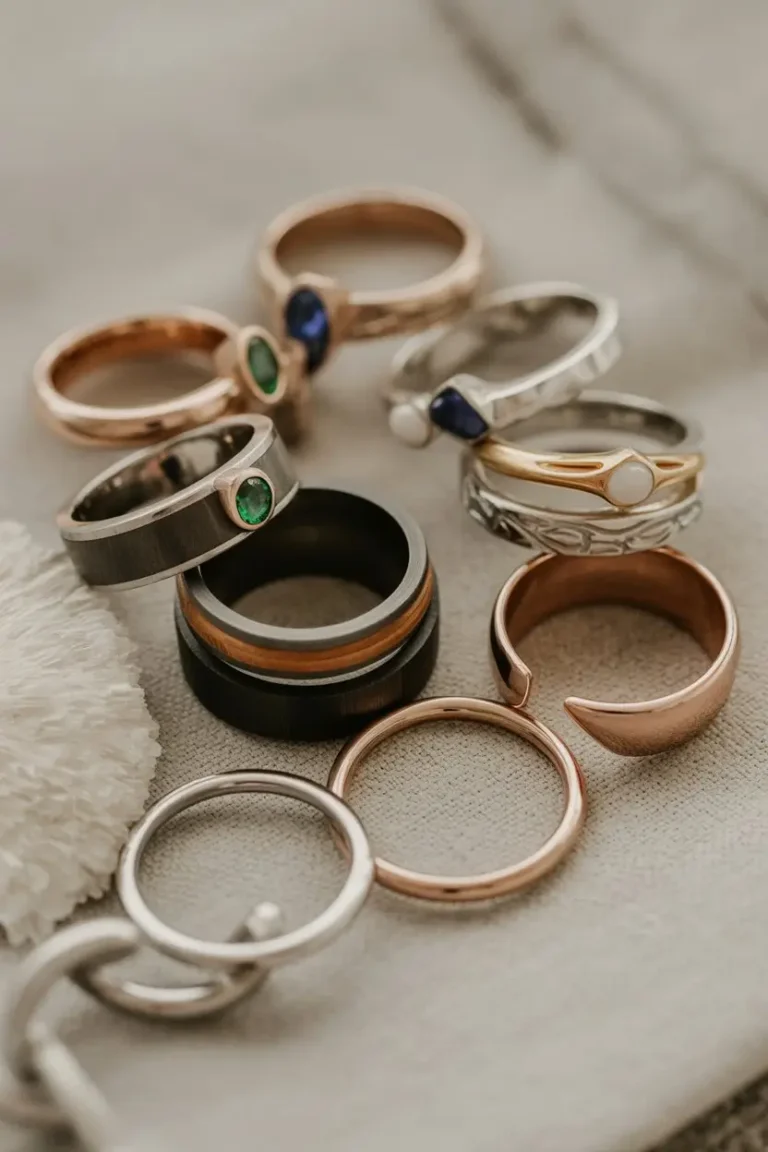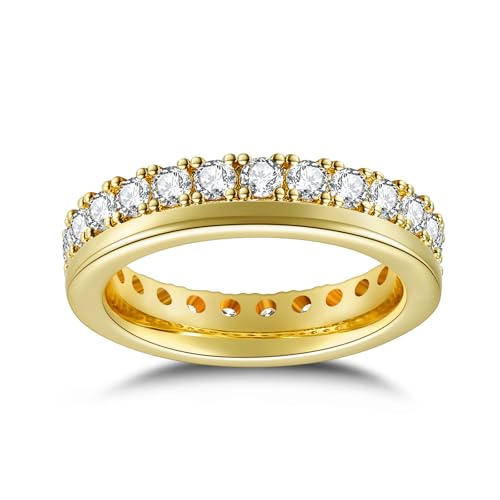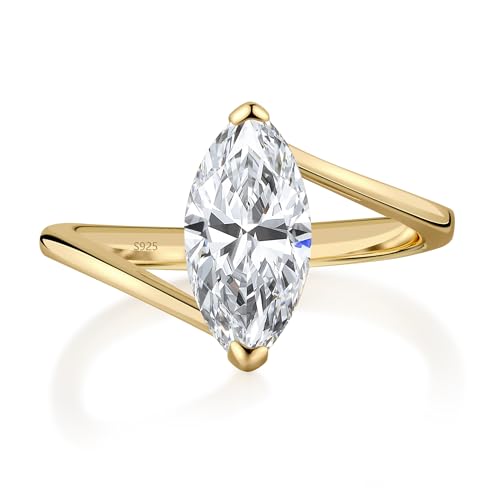Tradition has a timeless charm, but many couples want rings that reflect their real lives, values, and style today. That can mean a band made from a material that feels new in the jewelry case, a gemstone that tells a story, a silhouette that bends the rules, or even skipping a ring entirely. The point is not to be different for the sake of it. The point is to wear a symbol that feels true every day.
Personal tastes differ. So do jobs, hobbies, and budgets. The non-traditional route, including non-traditional wedding rings, opens up a wider toolkit to match those realities with a ring that still feels ceremonial and enduring.
Why more couples are skipping the classic template
Classic designs keep their appeal for good reasons: they are familiar, easy to care for, and widely available. Yet a growing share of couples want rings that signal more than convention. That might mean a band that looks sculptural, a gemstone with character, or an artist’s touch you can spot from across a room.
There is also a practical shift. People work with their hands, lift weights, climb, code, cook, and commute. Many do all of those in a single week. A ring that can take a beating or come off quickly for a workout is valuable. Ethical sourcing and sustainability matter too, and that often leads to recycled metals, lab-grown stones, or heirloom resets instead of new mining.
Money plays a part. Alternative gems bring color and personality at prices that leave room for a dream honeymoon or a down payment. And that is a tradeoff a lot of couples are happy to make.
Materials beyond gold and platinum
Gold and platinum are still stellar options, especially when recycled or Fairmined. That said, new alloys, forged steels, and ceramics have raised the bar for durability and design range. Some offer a deep gray or inky black tone, others a featherlight feel, and a few have patterns right in the metal.
Here is a quick comparison to help map priorities like maintenance, possible resizing, and skin sensitivity.
| Material | Look | Strength | Resizing | Care | Notes |
|---|---|---|---|---|---|
| Recycled gold (yellow, rose, white) | Warm tones, classic | Medium | Usually possible | Clean with mild soap, polish as needed | White gold often rhodium plated, replating every 1 to 2 years for bright white |
| Platinum | Silvery white, dense | High, malleable | Usually possible | Regular cleaning, repolish patina if desired | Hypoallergenic, develops soft gray patina |
| Palladium white gold | Cool white, no nickel | High | Usually possible | Same as gold | Better for nickel sensitivity, keeps white color longer |
| Titanium | Cool gray, very light | Very high | Rarely sized | Simple soap and water | Great for active wearers, low cost |
| Tungsten carbide | Dark gray, heavy | Extremely hard, brittle | Not sized | Wipe clean, avoid hard impacts | Very scratch resistant, can fracture on strong impact |
| Cobalt chrome | Bright white | High | Limited | Basic cleaning | Bright look like white gold, may affect nickel sensitive skin |
| Tantalum | Deep gray-blue | High | Limited | Minimal care | Smooth finish, comfortable weight |
| Black zirconium | Matte black surface | High | Limited | Avoid abrasive polishing | Heat-treated surface turns black, inner core gray |
| Damascus steel | Patterned waves | High | Rarely sized | Dry after water, light oiling | Pattern from layered steels, may need rust care |
| Meteorite (iron-nickel) | Natural Widmanstätten pattern | High, can rust | Not sized | Dry immediately, oil lightly | Avoid frequent water exposure, contains nickel |
| Stainless steel | Neutral gray | High | Limited | Basic cleaning | Budget friendly, good for first-time wearers |
| Ceramic (zirconia) | Glossy black or white | Very hard, brittle | Not sized | Wipe clean | Lightweight, won’t bend, can crack if dropped |
| Carbon fiber | Black weave | High, light | Not sized | Mild soap, avoid solvents | Great for wide bands, modern feel |
| Wood or antler inlay | Organic texture | Varies | Not sized | Keep dry, refinish if needed | Avoid pools, hot tubs, prolonged moisture |
| Enamel accents | Colorful glassy areas | Surface hardness, can chip | N/A | Avoid hard knocks | Vibrant color, best for occasional polishing |
| Silicone | Soft, matte | Flexible | Replaceable | Soap and water | Safe for sports, electricians, and medical settings |
A few quick tips:
- Nickel sensitivity is common. If your skin reacts, choose platinum, palladium white gold, titanium, tantalum, or ceramic.
- Black coatings on standard metals tend to wear at high-contact points. Black zirconium is different because the black layer is created by heat-treating the metal.
- Meteorite looks incredible, but it will rust without care. Mineral oil and careful drying keep it handsome.
- Tungsten and ceramic resist scratches but cannot be resized. Pick sizing with extra care or choose a comfort-fit that gives a bit more room.
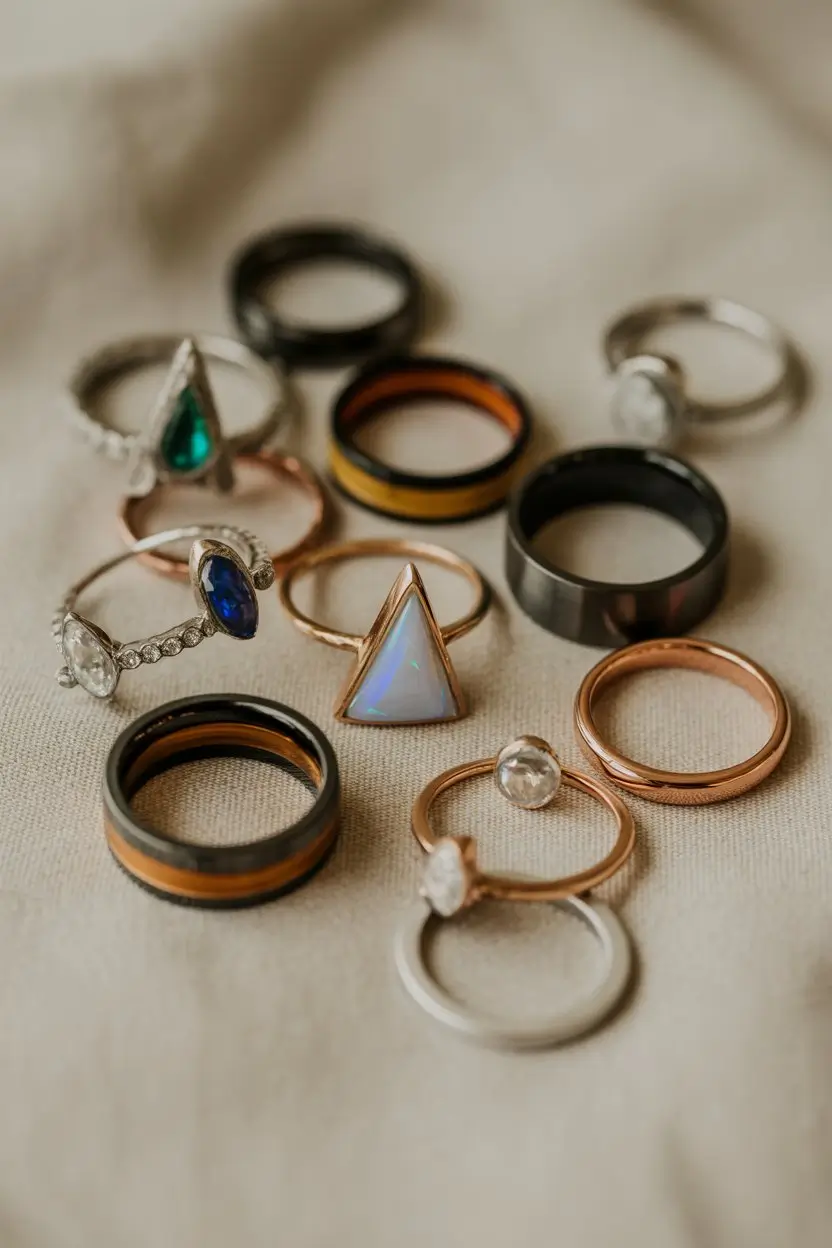
Gemstones with personality
Color is having a moment. Sapphires in peach, green, and steel gray. Spinel in cool lavender or saturated red. Tourmaline in glowing teal. These stones have presence without shouting, and they often cost less than diamonds of similar size.
Diamond still matters, both mined and lab-grown. Lab-grown offers high clarity and size for less. Salt and pepper diamonds with natural inclusions feel raw and cosmic. Portrait-cut diamonds look like panes of glass and sit close to the skin for a modern profile.
Moissanite has high brilliance and durability, with a flashier sparkle pattern that some people love. Emerald, opal, and pearl carry romance, but they need extra care. Emerald can chip at corners. Opal is sensitive to dryness and shock. Pearl hates abrasion and chemicals.
Durability basics to keep in mind:
- Diamonds sit at 10 on the Mohs scale and are very hard, but they can still chip at edges.
- Sapphires and rubies are 9 and handle daily wear well.
- Moissanite is 9.25 and very durable.
- Spinel and topaz land around 8, suitable with protective settings.
- Tourmaline lands around 7 to 7.5, best with bezel or low-profile settings for daily wear.
- Opal and pearl live below 6, better for occasional wear or protective settings.
Small side stones can shift the mood. A ring with a main gemstone paired with tiny black diamonds, tapered baguettes, or a gradient of colored sapphires feels tailored and fresh.
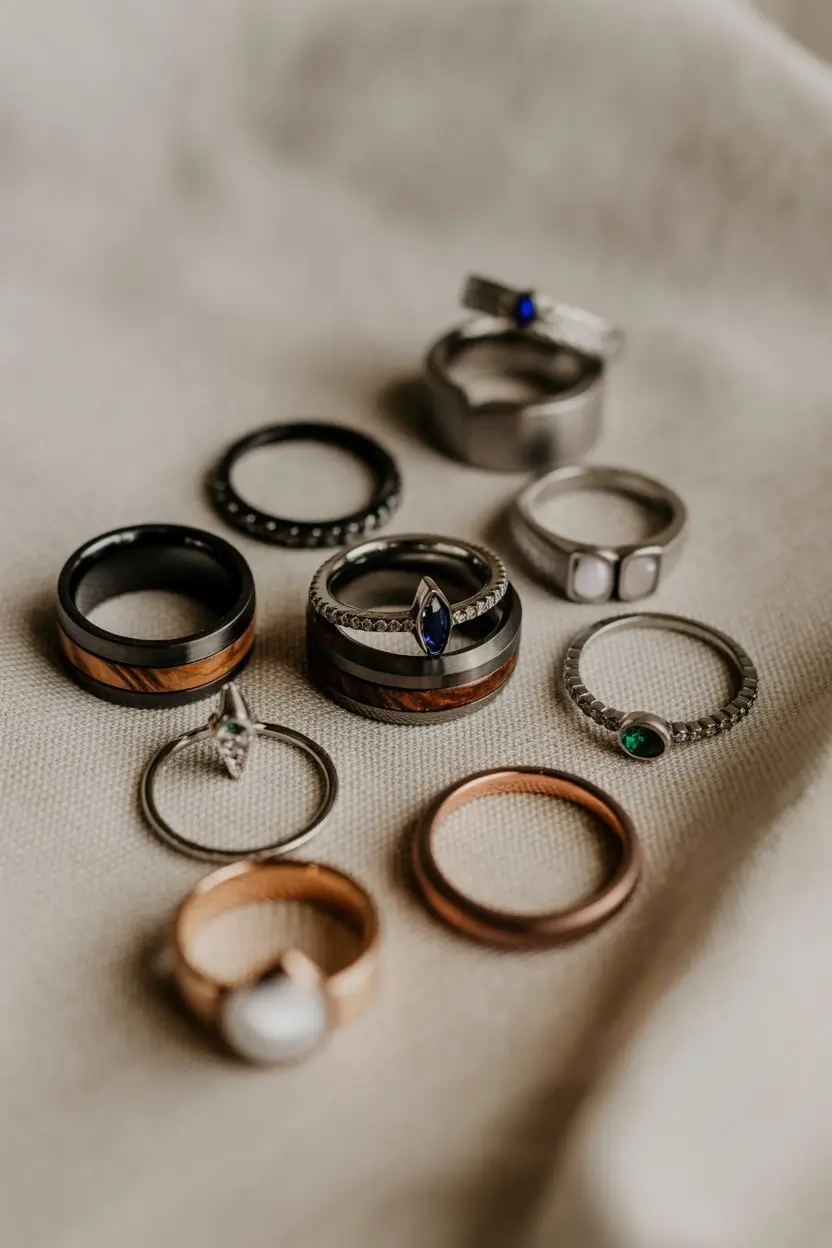
Shapes and settings that bend the rules
Classic prongs raise the stone and invite light. Newer silhouettes trade height for sculptural lines and security.
- East–west: elongated stones like ovals or emerald cuts set horizontally.
- Toi et moi: two stones meeting at the center, perfect for pairing different shapes or colors.
- Bezel and gypsy: a metal rim hugs the stone, smooth to the touch and gym friendly.
- Flush setting: stones sit level with the band, great for people who type or lift.
- Open bands and negative space: airy, graphic, easy to stack.
- Signet profiles: flat top surfaces engraved or set with a low gemstone plaque.
- Knife-edge or faceted bands: crisp lines that catch light without adding height.
One more underused idea: mixed metals in a single band. A platinum top for durability and a yellow gold inner sleeve for warmth feels considered and comfortable.
Bands that pull in tech
Smart rings can serve as wedding bands. Some couples wear an activity tracker ring in a metal sleeve or opt for a fitness ring finished with a polished edge. NFC rings can hold a private contact card that only your partner can scan. Payment rings exist too, though not every bank supports them.
Keep in mind:
- Most tech rings cannot be resized and may require a dedicated charger.
- Some have surface coatings that scratch faster than jewelry-grade metals.
- If you love the health data, pair the tech ring with a simple metal band for events.
Personalization that feels real
Initials and dates still work, but the range is wider now. If you want more than a stock engraving, consider:
- A line from vows in your handwriting, etched on the inner shank.
- GPS coordinates from where you met or got engaged.
- A soundwave of a whispered promise or a laugh.
- A tiny gemstone hidden inside the band in your partner’s birth month.
- A sand cast that includes grains from a shared beach or trail.
- A hammered or stardust texture that a jeweler can refresh over time.
- A pattern inspired by architectural details from a meaningful place.
3D printing and hand carving make this practical. A jeweler can model your idea, print a resin, and cast in your metal of choice. That gives you a preview before committing.
Style for every lifestyle
Good design is honest about daily life. If you weld, cook, or lift weights, your ring should be ready for it.
- Hands-on work: choose platinum, palladium white gold, or titanium with low-set stones or no stones at all. Bezel or flush settings reduce snags.
- Athletes: silicone bands are safe during training. Keep a metal band for dress and switch for the gym.
- Musicians: slim comfort-fit bands glide under strings and along keys.
- Medical staff: easy to clean and low profile. Consider platinum or palladium and smooth settings that stand up to sanitizer.
- Electricians: avoid conductive metals on the job. Use silicone during work hours.
- Allergy prone: platinum, palladium white gold, titanium, and ceramic are safer picks. Test a small inner-sleeve band first if unsure.
Price, value, and smart budgeting
Non-traditional wedding rings can be budget-friendly or wildly intricate. Prices stretch with metal weight, gemstone rarity, and bench time. A few pointers help maximize value without cutting corners.
- Recycled or lower-karat gold reduces cost and still wears beautifully.
- Lab-grown diamonds, moissanite, and colored gems unlock size options for the same budget.
- Simple geometry and a single standout detail beat busy designs that trap dirt or snag.
- Factor in maintenance. White gold replating, prong checks, and stone tightening cost money over the years. A sturdier bezel may cost more now and less later.
- Insurance for high-value pieces is smart. Keep receipts and a current appraisal.
- Resale on niche materials can be thin. If future trade-in matters, stick to precious metals and classic weights.
Sizing, comfort, and ergonomics
A ring you forget you are wearing is the true luxury. Fit is a blend of width, thickness, profile, and season.
- Width: wider bands feel tighter. Move up a quarter to half size for bands 7 millimeters or wider.
- Thickness: a slim cross-section sits closer to the hand and feels lighter. Too thin can bend. Aim for a balanced profile.
- Comfort fit: a gentle inner curve that slides over the knuckle with less friction. Many prefer it for daily wear.
- Season and time: fingers swell in heat and late in the day. Measure in the afternoon, and consider sizing slightly larger if you live in a hot climate.
- Resizing limits: eternity bands, tension settings, ceramic, tungsten, and some steel rings cannot be resized. If your size shifts, you may need a new ring.
- Arthritic knuckles: hinged shanks and adjustable designs exist. Ask a jeweler to demonstrate.
Care and durability
Regular care keeps a non-traditional ring looking sharp.
- Cleaning: warm water, mild dish soap, and a soft brush handle most dirt. Rinse well and pat dry.
- Ultrasonic cleaners: safe for diamonds, sapphires, rubies, and moissanite in sturdy settings. Avoid with emerald, opal, pearl, and heat-treated or fracture-filled stones.
- Rhodium plating: white gold stays bright with periodic replating. Platinum can be polished or left with a soft patina.
- Matte finishes: reapply by a jeweler when they get shiny. A quick refinish brings back texture.
- Black finishes: black zirconium holds color well, but surface scratches show gray. Coated black gold or PVD finishes wear faster.
- Meteorite: keep dry, wipe after water, and oil lightly to prevent rust.
- Wood or antler inlays: remove for pools, hot tubs, and heavy dishwashing. Store in a dry place.
- Enamel: avoid hard knocks and thermal shock.
A yearly check for loose stones and thinning prongs is smart. Think of it like a tune-up.
Try these unconventional alternatives
Some couples opt for non-traditional wedding rings or supplement them with other symbols.
- Ring tattoos: permanent and personal. Choose an artist who specializes in fine lines, and plan for yearly touch-ups.
- Permanent bracelets: welded chains with a tiny charm. Minimal and ritual-friendly.
- Pendants: hang the ring on a chain during travel or workouts, or wear a small signet on a chain year-round.
- Matching coins or tokens: carry-ins with custom engraving or enamel.
- Ear or cartilage jewelry: a pair of fine hoops or studs that match, worn daily.
Ritual matters. The form can change.
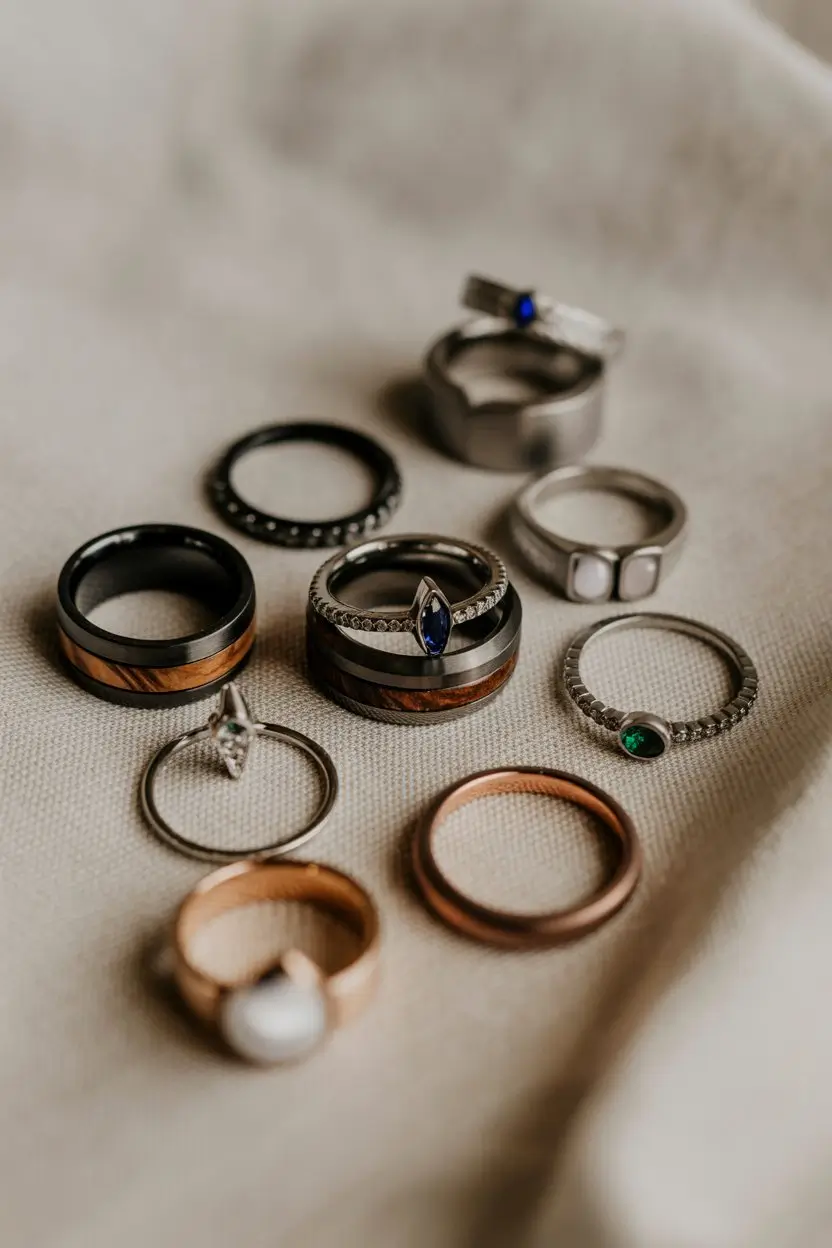
A smart checklist for meeting a jeweler
Bring this to your appointment or a virtual consult.
- Materials: which metals match my lifestyle and skin? Can you show me samples in different widths and thicknesses?
- Resizing: can this ring be resized in the future? If not, what is your remaking policy?
- Sourcing: do you offer recycled metals, Fairmined gold, or traceable gemstones? Can I reset an heirloom stone?
- Setting security: how often should prongs or bezels be checked? What is covered by your warranty?
- Finish: can a matte or textured finish be refreshed later? What will it look like with wear?
- Allergies: any nickel or cobalt in this alloy? Are there palladium options?
- Timeline: what is the lead time for custom work, and how many design revisions are included?
- Care: cleaning guidance, safe ultrasonic use, and how to spot loose stones.
- Backup band: do you offer silicone or travel bands in matching sizes?
Where to find standout makers
- Local studios and art schools often host jewelry sales with one-of-a-kind pieces. You get to try on, feel weight and balance, and meet the person who will maintain it.
- Independent designers online share process videos and client galleries that help you judge craftsmanship. Look for clear photos of the inner shank, prongs, and side views.
- Ethical retailers and collectives list each material and stone with sourcing notes. Certifications help, but transparency and a shop’s repair history say even more.
- Vintage and estate shops are treasure troves. Resetting an antique stone in a modern setting creates a ring with history and clean lines.
Virtual try-on tools help with scale. Even so, nothing beats slipping on bands in different widths and profiles.
Trends to watch this year
Trends are snapshots. They come and go. Still, they can spark fresh ideas.
- Chunky signets with satin tops and a single off-center stone.
- Black zirconium bands with bright platinum inlays.
- Gradient sapphire bands that flow from deep blue to icy white.
- Toi et moi rings pairing moissanite with colored gems.
- Portrait-cut diamonds in bezels that sit close to the finger.
- Mokume gane patterns inspired by wood grain, done in warm tri-metal palettes.
- Reset heirlooms with minimal bezels and knife-edge bands.
- Engraved narratives inside the band, like a skyline or mountain line.
A short glossary for quicker decisions
- Bezel: a metal rim that surrounds the stone for security and a low profile.
- Comfort fit: a rounded inner surface that feels smoother on the finger.
- Gypsy setting: a stone set flush into a solid band, often seen in vintage signets.
- Mohs hardness: a scale that ranks scratch resistance from 1 to 10.
- Patina: the soft, lived-in surface that develops on metals like platinum over time.
- Portrait cut: a thin, flat diamond or colored stone that looks like window glass.
- Toi et moi: two stones meeting at the center as a pair.
Design prompts to kickstart your ring
- Think about your favorite object at home. What textures or colors show up on it, and could those appear on a ring?
- Name three places that shaped you both. Could coordinates, map lines, or local materials play a part?
- List five daily tasks where a ring might snag. How could a setting avoid those moments?
- Recall an heirloom from your family. What part of its look feels timeless to you?
- Choose a word that sums up your partnership. How might a jeweler translate that into line, proportion, or contrast?
A ring that honors real life has depth. It can be art and armor, keepsake and tool, quiet and bold, all at once. When you give yourself room to choose beyond the standard, your options widen and the result often feels more like you.

